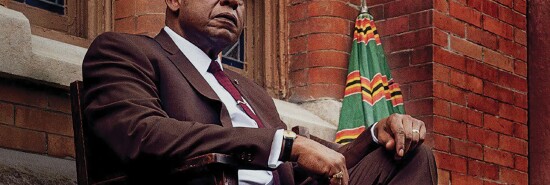
Godfather of Harlem is a much-too-ignored historical drama
Chris Vognar
The crime lord Bumpy Johnson found himself in a tight spot in the recent season three premiere of Godfather of Harlem. A massive heroin score had literally gone up in smoke, burned along with much else in the 1964 Harlem uprising. This was a deal Bumpy had undertaken with New York’s five Mafia families. Now he owed them $3 million with no immediate means of procuring the cash. So he did what he hates doing. He took from his own people, robbing the Liberty Bank of Harlem, and killing an innocent guard in the process, to pay back the men he derisively refers to as “the guineas.” You can see the pain and conflict etched across the face of Forest Whitaker, who has turned Bumpy into a character of Shakespearean proportions. He loves Harlem so much that he refuses to let anyone else run it and poison his people with dope. Only he can do that.
While Succession racks up the awards, and Yellowstone wins the ratings, Godfather of Harlem has quietly become one of the most compelling stops on the dial, a sprawling work of historical fiction that turns the study of divided loyalties and racial pride into blood-soaked poetry. It’s a crime drama that audaciously juggles historical figures from Rep. Adam Clayton Powell and Malcolm X to Lyndon Baines Johnson and Robert M. Morgenthau. It’s an interrogation of American capitalism in its legal and illegal forms, as Bumpy treats every drug deal like a game of chess and learns to play nice with prominent bankers and judges. And it’s a gripping encapsulation of American racism that asks hard questions. To use the ballot or the bullet? To fight from the inside or the outside? And what happens when you veer from your common enemy and start killing your friends instead?
The real Bumpy Johnson was a Harlem crime boss who worked with Lucky Luciano and battled Dutch Schultz before getting sent to Alcatraz for 11 years. He cultivated a man-of-the-people persona, a ruthless killer who often did his work with a straight razor but was also beloved by much of his community, which he infused with money as well as drugs. Godfather of Harlem picks up with his post-Alcatraz return to his neighborhood and his wife, Mayme (Ilfenesh Hadera), and his fight to secure the Harlem heroin trade from his Italian competitors, principally Vincent “Chin” Gigante (a volcanic career-best performance from Vincent D’Onofrio). Gigante, who partnered with Bumpy when it was financially expedient, has problems of his own. His daughter, Stella (Lucy Fry), finally ratted him out to Morgenthau’s feds after he orchestrated the murders of not one, not two, but three of her lovers. Now Stella’s mother (Kathrine Narducci) has put a hit out on her daughter.
That’s just scratching the surface of the show’s many goings-on. Godfather of Harlem definitely works on a potboiler entertainment level. But many of its thrills are more substantial, especially the development of Malcolm X. Malcolm and Bumpy were friends in real life, a relationship with which we see the show’s Malcolm wrestle. But the Malcolm character lives and breathes on his own, as he, like many of the characters, looks within to figure out how best to empower black people. He, too, has shifting alliances, with Bumpy and with Powell (played with purring unctuousness by the great Giancarlo Esposito), a savvy power broker in his own right. There’s an inevitable sense of fatalism here as we watch Malcolm fall out of favor with Elijah Muhammad (Clifton Davis) and march toward what we know will be his doom. In the first two seasons, Malcolm was played by Nigel Thatch, who brought a brooding interiority and perfect pitch to the role. Due to a reported scheduling conflict, Thatch has been replaced with Jason Alan Carvell in the new season. Thatch will be missed; his performance was a sort of moral compass for the series.
Series co-creator Chris Brancato has been down the Bumpy road before. He wrote the screenplay for the 1997 movie Hoodlum, which starred Laurence Fishburne as a younger version of Johnson, with Tim Roth playing Schultz, Andy Garcia as Luciano, and Cicely Tyson as crime queenpin Stephanie St. Clair. The movie wasn’t very good. Its scale wasn’t sufficient to say much about the black gangster as an avatar of getting over on The Man, something the 2007 movie American Gangster did with grit and panache. Johnson was only a minor character (played by Clarence Williams III). The focal point is Denzel Washington’s Frank Lucas, also a real-life gangster, presented as a Johnson protege who took over the rackets and built his own heroin empire after Johnson died in 1968. (Like Godfather of Harlem, American Gangster is highly entertaining and highly fictionalized.) You’ll also find Johnson-like characters in the blaxploitation movies Shaft and Black Caesar (although there was also a real-life “Black Caesar,” the drug trafficker Frank Matthews, who disappeared in 1973).
Godfather of Harlem is after something bigger, and even with the occasional melodramatic indulgence, it succeeds gloriously. Like the most imaginative and ambitious historical fiction, it creates an entire shadow history — of the ‘60s, of the civil rights and Black Power movements, of organized crime. This season, Bumpy will take on the Cuban Mafia and the CIA, which means we’re entering The Godfather: Part II territory — sacred ground for any gangster saga. Godfather of Harlem has earned the right to go there. It has the pulp and the juice. Kudos to MGM+ (formerly Epix) for re-upping the series for another season. It deserves an audience.
Chris Vognar is a culture writer living in Houston.
